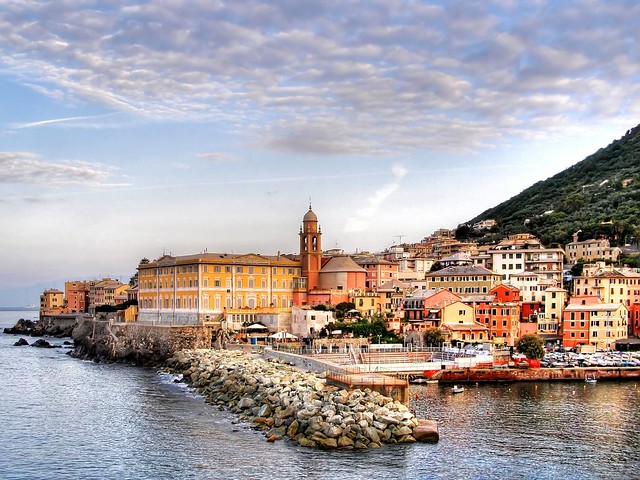 Genoa area
Genoa area
Genoa extended its borders around the bay well beyond the Old Town. Thanks to good bus and train connections, at weekends, the parks and seaside boulevards of Nervi and Pegla are popular (towards Savona). It is also worth visiting the areas located in the interior of the province, which in the spring, when the flowers bloom and the vines sprout new shoots, they are especially green and lush. You can choose from several small villages, or take the long route along the Ligurian mountains.
Nerves
The residential neighborhoods of Genoa to the east extend all the way to NERVI (access by train or bus # 17). lying around a small port. You can usually see fishermen sitting on the rocks or kayak enthusiasts, floating on the sea. Some people come to Nervi to visit the local bars, but most choose the beautiful one, winding walking path, which runs around the peninsula and through the gardens lying at the foot of the cliff. Located off the main road, Parco Municipale has an open-air cinema (VI-IX). In summer, the park also hosts the famous ballet festival. Even though Nervi is a suburb of Genoa, Thanks to the orange groves and lush gardens of the local villas, it is far from the atmosphere of a big city.
Pegli
West of Genoa, in the vicinity of the airport, there are municipal heavy industry plants. Their greatest concentration is in the suburban Sestre Ponente, which is a gloomy line of steel mills and apartment blocks. Trains and slow line buses # 3 from the Stazione Principe, they pass this towards the formerly separate one, and today the summer resort of PEGLI, incorporated into the city. Other places are better suited for sea bathing, but Pegli has its own attractions. Należy do nich Villa Durazzo-Pallavicini, actively defended against destruction by the local communist party. The villa is set among gardens, shaped according to the tastes of the 19th century, dotted with waterfalls and pagodas, and now it houses the Museo Civico di Archeologia Ligure (Tue-Sat. 9.00-13.00 and 14.00-17.00; 2000 L). Items extracted from tombs found in mountain caves on the west coast of Italy are collected there, including the skeleton of a young prince with a sea-shell crown and a ceremonial dagger.
North of Genoa
Many Genoese leave the city in summer, heading for the mountains in the interior of the province. A side railroad runs from Genoa to CASELLA, where is it from 12 kilometers to Lago di Val Noci. A narrow path disconnects from the route that runs to the lake, which climbs the Val Brevanna to the mountainous Parco Naturale delPAntola. On the way, old villages are passed, which in the Middle Ages were contested by the Spinola and Malaspina families, the bishops of Tortona and the Republic of Genoa. Here and there, on the edge of the village, you can see the walls of a castle built by one of the parties to the conflict falling down.
Two roads lead to the mountains from Genoa: to Tortona in Piedmont and to Piacenza in Emilia-Romagna. It also leads to Tortona and Milan, along the A7 motorway and the SS35 road, main railway line, traversing the hills planted with fruit trees and vines. Alta Yia dei Monti Liguri joins the road to Tortona on the Passo di Giovi pass. BUSALLA is not far from here, a traditional stopping place on the route from Genoa to the Po Valley. Busalla has two hotels: Vittoria, Via Veneto 177 (»932907), with rooms behind 22 000 L oraz Apennines, Borzino Square 8 (» 9340780), at the price of approx. 13 000 L for the room. Several trains a day stop in Busalli.
Meanwhile, the road to Piacenza passes through the town of TORRIGLIA, the main center of this agricultural, a region cut off from the world by mountains. The hotels here are a good base, if you want to explore the wild, areas located to the north. Hotel Aurelio is located here, Square E. Piaggio 20, with rooms behind 36 000 The oraz Della Posta, Via Matteotti 39 (in 944050), where you pay for the room 24 000 L. Further on this route is the village of MONTEBRUNO. It is famous for the richly decorated 15th-century Santuario dclPAssunta (where there is a Byzantine statue of the Madonna) and from mushroom-shaped chocolates, called funghetti. However, on the outskirts of ROVEGNO, on the border of Emilia-Romagna, it is used for the first time in the 11th century, and made operational again at the beginning of our century, copper mine.